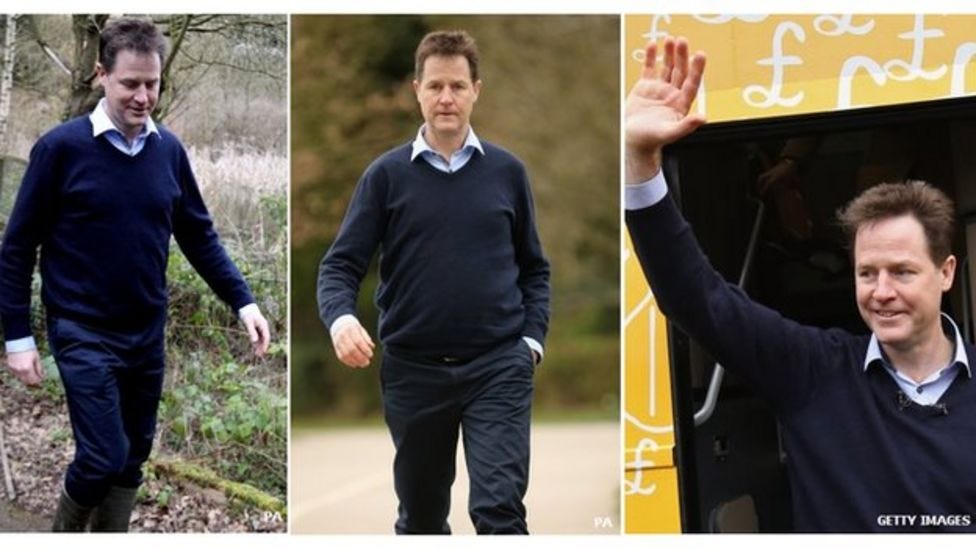The rise and (probable) fall of smart casual writing
How business English came to mirror the prevalent dress code of the developed world in the 21st century – and why it's now in danger
Style. There’s an interesting and versatile word. A much-abused one too. You can apply it to lots of things. In this blog, I’m especially interested in two: how we dress and how we write.
They are very closely linked. Here is a theory for you. English usage and fashion evolve at a similar rate – constantly, quickly, but when you stand back and survey the decades, even the centuries, big themes are unmissable.
And here is the biggest: everything becomes more casual.
Think of the way a gentleman dressed in, say, the late 18th century. Think of the periwigs, the buckles, the braid, the waistcoats, the frills. Then consider a piece of prose from the same era. The language is elevated, even arcane to modern eyes and ears. You notice how all the Nouns begin with Capital Letters, how elaborate the punctuation is, how long the paragraphs and latinate the subclauses.
Then think of yourself in 2022, reading this on your phone in your yoga pants and t-shirt, breaking off to send a whatsapp without punctuation, pronouns, maybe even without words, but colourful little symbols and illustrations. Think of the stages we’ve been through in between. We lost our stays, our corsets, our hats, our ties; and we’ve replaced words with apostrophes, ditched the subjunctive, gone lower case, written tweets instead of articles, status updates instead of letters.
But in this piece I want to concentrate on a dominant theme. In fashion, we call it ‘smart casual’ or, sometimes, business casual. It’s on the party invitations (sorry, ‘invites’) we get. It’s still the dress code in offices where they have one (and where people still go to an office).
It says in Wikipedia that the term has been around since 1924; but I reckon the heyday really started at the end of last century, when minimalism emerged as the dominant aesthetic. Men ditched their ties, women their jackets.
I’ve not seen ‘smart casual’ applied to writing: but I realise that’s exactly what we’ve been teaching, and using, in business English for that same period of time.
So, what is smart casual writing?
Some phrases to consider.
That certain au fait individuals should consider how English might evolve at a commensurate pace with one’s chosen way of dressing, may thus be considered a phenomenon not entirely without merit.
I’m like hello everyone writes stuff like whats ok for them…whatever that’s cool.
Look at those sentences and imagine how the person writing them is dressed. The first man – I feel he is a man, possibly in the Jacob Rees-Mogg mould – is certainly in a suit, possibly a three-piece one. He has polished black shoes. There’s perhaps a hint of ages past – a vintage wristwatch? Braces? – and certainly a pocket handkerchief.
The second guy – that’s a gender-nonspecific term – may not be wearing much at all, but what it is will be loose, soft and take a matter of nanoseconds to put on or take off.
And here is the smart casual person…
Well, it’s me. It’s how I’m writing this blog. There is structure here. The sentences are proper English sentences. Or most of them. I might throw in a sentence without a verb – like the one that preceded this. It’s like wearing trainers with a suit. You’re presentable, but relaxed.
How else do you identify the smart casual way of writing?
It’s closely allied to the Plain English movement. The way you write shouldn’t be too different from the way you speak. That slightly depends on who ‘you’ are and how big your vocabulary is. But the point about smart casual as a code is that it’s democratic and can be adopted by anyone, regardless of class or background.
That is in sharp contradistinction to those who might hold the motto vestis virum facit to be a universal truth. Only those of a certain education and background use words like ‘contradistinction’ and know what vestis virum facit means*.
Smart casual writers like me love to broadcast our jettisoning of old-fashioned rules, or rules-that-never-were rules, just as the first smart casual pioneers loved wearing jeans at Le Caprice. We put prepositions at the end of sentences – there’s no rule that we know of. And we start them (sentences) with conjunctions. And to boldly split and infinitive – why not?
There came a point when if you turned up at Le Caprice in a suit and tie, they’d sit you out of sight in the back of the restaurant. At around the same time, every organisation’s style guide said they wanted to use language that was ‘warm’, ‘human’ and ‘accessible’.
So, when will the era of smart casual end?
I don’t know for sure, but I can date the beginning of the end: April, 2015.
There was a General Election on, and wags in the media and online began to notice how similar the three party leaders were speaking, messaging – and dressing. (The same happened in the 2010 election, when Cameron, Clegg and Brown all wore similar dark suits and open-necked blue shirts on a day of campaigning).
Ambitious politicians ever since have embraced idiosyncrasy and personal style. There is Nigel Farage and his posh farmer look. Boris Johnson with his crumpled suit and messy hair. And Donald Trump, who wants to take America back to a time – around 1985, I reckon – when men were men, men ALWAYS wore ties (except on the golf course) and women were there to be grabbed.
At the other end of the political spectrum, dress, like language, has become a battleground of signifiers and statements.
Just as the middle ground of politics has disappeared, so has the middle ground of dress and language. We’re polarised; we’re each seeking our own identity. For businesses, the comfy certainties of the smart casual era of expression are being replaced with a nervous fluidity.
Me, I liked the middle ground and I was very happy in smart casual. I never did like ties much; but then wearing trainers with a suit is not something I’ll ever get used to, anymore than I can help wincing whenever I hear the word ‘like’ more than once in a sentence, or when that word is used as a substitute for a verb when connected to the personal pronoun.
I’m, like, so over. Guess that’s evolution. Get used to it.
But if you know a better way of writing in a clean and understandable way that reaches the maximum number of people – please do tell.
Forthwrite is a UK-based consultancy offering courses on strong writing and clear communication.
Clothes maketh the man (Erasmus)









